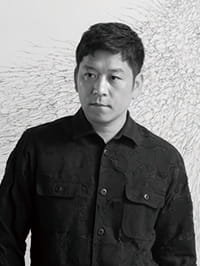名和晃平個展「ORACLE」
Nawa is based in Kyoto out of his studio, Sandwich, which recently celebrated its tenth
anniversary. As an homage to the Kamakura-Period sculpture Kasuga Shinroku Shari Zushi, he
presents Trans-Sacred Deer (g/p_cloud_agyo) – also known as Shinroku – produced using
woodcarving, urushi lacquer, and gold and platinum leaf techniques. This work is part of a
project that Nawa has been developing for a few years, and aims to promote traditional
crafts in Kyoto. The current pandemic made international travel problematic, but it mostly
gave him the opportunity to spend time in the studio and work on a variety of new creations:
this show reveals a selection of the pieces born from his last experimentations, including
paintings in which he produced complex materiality and textures by combining multiple art
media, paints, and oils, as well as new works using UV lasers. GYRE's atrium features
“Silhouette,” a sculptural installation that was developed for pianist Koki Nakano’s concert
stage in Spiral Hall in Tokyo and ROHM Theatre Kyoto in 2018. Revolving bodies made of
curves extracted from melodic sound determine the volumes, while highly reflective silicon
carbide beads cover the surface “skin.” The exhibition coincides with the Centennial
Celebration of the Establishment of Meiji Jingu. White Deer (Meiji Jingu) is exhibited in
front of the Meiji Jingu Museum and Ho / Oh, produced using the same woodcarving, lacquer,
and gold/platinum leaf techniques as Shinroku, are on display at the southern gate in front
of Meiji Jingu’s main shrine. These sculptures mark the way from Omotesando to the main
shrine and represent hope for a new future.
*The title of the exhibition,Oracle, is a reference to things that provide a divine
revelation, divine will, and guidance.
Exhibit Works
-
PixCell-Crow#5
PixCell
* PixCell: Pixel (picture element) + Cell ("PixCell" is a term coined by Nawa)
-
PixCell-Reedbuck (Aurora)
――
-
Black Field
Black Field
In the early stages of the creation process, even the flat parts crinkle over the course of two to three weeks, and the parts that can no longer withstand the tension in the skin crack. In the parts that have cracked, the oil paint, containing liquid rich in oil, is exposed, and a new reaction begins. This process, in which phenomena are transformed into representation, is similar to what happens to soil exposed to repeated cycles of wind and rain and dry weather, and the cracks bring to mind the cells in the skin of plants called stomata that open and close in response to changes in turgor pressure.
――
-
「Trans-Sacred Deer (g/p_cloud_agyo)」
Trans
Trans-Sacred Deer (g/p cloud) was first created from data with a 3D modeling system, and made using traditional techniques such as woodcarving, lacquer, and gold and platinum leaf. Its motif is the shinroku deer depicted in the Kasuga Shinroku Shari Zushi sculpture, which is deemed to have been made sometime between Japan's Kamakura Period and the Northern and Southern Dynasties Period.
The deer in Trans-Sacred Deer (g/p cloud) has a cloud-like form, and the Kaen Houju (flaming sacred jewel) is enshrined on top of a lotus pedestal mounted on the deer's saddle. It is as if a messenger of the gods has been summoned and, spanning the ages, has now appeared in this world.
――
-
Dune#16
Dune
In the Dune series, things such as multiple types of media, paints with different granularity, and water are mixed, and then poured and spread over the support, producing a variety of different types of expression due to the relationship between the viscosity of the medium and the angle of the canvas. With Dune, paint left over from the Direction works after flowing down and off the canvas due to gravity, is recovered and reused on a level surface. The complex expression resulting from the differences in materiality produces the feeling of looking down and seeing the interrelationship between atmospheric phenomena and the landscape.
-
Dune#15 -
Dune#11 -
Dune#5 -
Dune
――
-
Blue Seed_A, Blue Seed_B
Blue Seed
Usually with drawing, the artist faces the question of whether to fix the image created on the canvas, but with Blue Seed, the images are repeatedly generated by computer and then fade naturally, without ever being fixed. The images of seeds and ovules, which have the potential to grow as individual lifeforms, indicate the birth and ephemeral nature of life, which may flicker tenuously, but also possesses permanence as a continuous system.
Program: Ryo Shiraki / Soundscape: Marihiko Hara
――
-
Silhouette#2
Silhouette
In the garden of F-Art House on the island of Inujima where he presented Biota as part of Setouchi Triennial 2013, Nawa arranged a number of Ether series works: symbolic expressions of the relationships between water, life, and gravity. Despite their quiet presence, each is imbued with the dynamism of wave motion and energy.
――
-
Catalyst#21
Catalyst
The thermoplastic glue that forms these networks becomes liquid when heated by a glue gun, but cools again when it adheres to the support, returning to solid form and becoming firmly fixed in place. Aggregations of transparent lines of glue develop into forms reminiscent of expanding neural networks, plant creepers growing in search of light, or slime molds. In the resulting shapes can be seen the urge to move upward in opposition to the pull of gravity, horizontal extension like that of spreading wings, and the downward stretch of stalks or stems.
These works at the interface between inorganic and organic seem to challenge our ideas of the desires and instincts programmed into cells, and our perceptions of the essence of life.
They bring to mind Nawa’s first work with glue, black yarn (2000, Gallery SOWAKA), which he created while in graduate school, vacillating between sculpture and drawing as he pursued inquiries into the long-standing question of when it is that materials or objects gain awareness.
――
-
Moment#162, Moment#163, Moment#164
Moment
With tracks of relative movement inscribed in this way, Moment serves to connect physicality with the Coriolis force produced by the inclination of the earth’s axis and centrifugal force, and with images of orbits or other manifestations of perpetual motion or mechanics in outer space.
Tiny reductions of pressure in the tank produce sporadic breaks in the lines, inscribing delicate rhythms and facilitating control of the density of the accumulation of lines, bringing temporo-spatial depth to the canvas. In order to demonstrate the link to the actual sensations appearing in Force and Direction, these Moment works are produced with the same colors and line widths as Force, and trimmed to the same 15-degree angle used in Direction.
――
-
Rhythm#1 (Velvet), Rhythm#2 (Velvet), Rhythm#3 (Velvet), Rhythm#4 (Velvet)
Rhythm
In the PixCell series, for instance, placing crystal glass spheres of many different sizes affects the way that a viewer’s sight moves over the motif. Giving a distinctive depth to its skin, this amplifies the visual effect. This effect is also related to the wider and narrower bands of Direction, which are produced by groups of spheres of different sizes moving in parallel.
In order to give a simple demonstration of the shared sensation that underlies each of these series, for his new series, Rhythm, Nawa covered all surfaces of the spheres and the support with neutral gray pile to create a consistent velvet finish.
The inspiration came from an experiment at placing wooden spheres on a board in Nawa’s Drawing Room (“DR”) in Daikanyama, Tokyo. The result was the rhythm of the large and small spheres, but nothing else. However, during the Covid-19 pandemic, the neutral nature of that experiment gained the appearance of something else. Ironically, that strange sensation held a certain fascination.
-
Kohei Nawa
-

Sculptor / Director of Sandwich Inc. / Professor at Kyoto
University of the Arts
Born in 1975, and based in Kyoto, Japan, Kohei Nawa received a PhD in Fine Art / Sculpture from Kyoto City University of Arts in 2003, and established Sandwich in 2009. Focusing on the surface “skin” of sculpture as an interface connecting to the senses, Nawa began his PixCell series in 2002 based on the concept of the cell, symbolizing the information age. Adopting a flexible interpretation of the meaning of sculpture, he produces perceptual experiences that reveal the physical properties of materials to the viewer through works addressing themes related to life and the cosmos and to artistic sensibility and technology, including Direction, in which he produces paintings using gravity, Force, in which silicone oil pours down through space, Biomatrix, in which bubbles and grids emerge on a liquid surface, and Foam, in which bubbles form enormous volumes. Recently, Nawa has also worked on architectural projects, including the art pavilion Kohtei. VESSEL, a performance work produced in conjunction with Belgo-French choreographer and dancer Damian Jalet, has been presented around the world since its premiere in 2015. In 2018, his sculpture Throne was exhibited under the Pyramid at the Musée du Louvre in Paris, France. -
Sandwich Inc.
-

Sandwich Inc. is a creative platform of
various disciplines based in a renovated sandwich factory near the Uji River in the Fushimi area of Kyoto. In addition to the studio, office, and workshop spaces, it has a residential area to provide accommodation. Led by Kohei Nawa, it functions as a space where creators from diverse fields, including architects, designers, engineers, choreographers, and dancers, can gather together to collaborate on a range of projects.
Kohei Nawa solo exhibition Oracle
-
Dates:
-
Friday, October 23, 2020 ‒ Sunday, January 31, 2021
-
Hours:
-
11:00 ‒ 20:00
-
Venue:
-
GYRE GALLERY, 5-10-1 Jingumae, Shibuya-ku, Tokyo
-
Cooperation:
-
SCAI THE BATHHOUSE, GRAND MARBLE, HiRAO INC, Sandwich Inc.